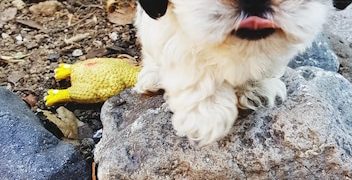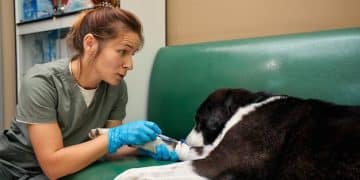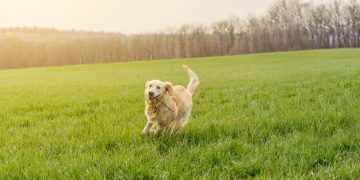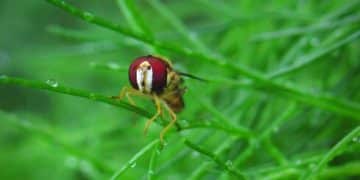Parvovirus Outbreak: Protecting Your Puppy with Vaccination and Hygiene

Parvovirus is a highly contagious and potentially fatal disease affecting puppies; timely vaccination and strict hygiene practices are crucial for protecting your young dog from this serious threat and ensuring its health and well-being.
The threat of parvovirus looms large for puppy owners. This highly contagious and potentially deadly virus poses a significant risk to young, unvaccinated dogs. Understanding the risks, symptoms, and prevention strategies is crucial for every puppy parent. Let’s explore how to navigate a Parvovirus Outbreak: Protecting Your Puppy with Timely Vaccination and Hygiene Practices.
Understanding the Parvovirus Threat
Parvovirus is a resilient and devastating virus that primarily affects puppies. This section explores the nature of the virus, how it spreads, and why puppies are particularly vulnerable.
What is Parvovirus?
Parvovirus, often shortened to “parvo,” is a highly contagious viral disease that affects dogs, especially puppies. It attacks the gastrointestinal tract, causing severe vomiting, diarrhea, and dehydration. In severe cases, it can also damage the heart muscle, leading to sudden death.
The virus is extremely hardy and can survive in the environment for months, even years, making it a persistent threat to unvaccinated dogs.
How Parvovirus Spreads
Parvovirus spreads through direct contact with infected dogs or their feces. It can also be transmitted indirectly through contaminated objects, such as clothing, shoes, and surfaces. The virus is so resilient that it can even be carried on a person’s hands or shoes to a new location.
This ease of transmission makes it critical to practice strict hygiene and sanitation, especially in areas where unvaccinated dogs may have been present.
Why Puppies Are Most Vulnerable
Puppies are particularly susceptible to parvovirus because their immune systems are not fully developed. They rely on antibodies received from their mother’s milk, which can wane over time, leaving them unprotected.
Additionally, young puppies have rapidly dividing cells in their gastrointestinal tract, which are prime targets for the virus. This rapid cell division makes them more severely affected by the virus’s destructive nature, leading to more severe symptoms and a higher risk of fatality.
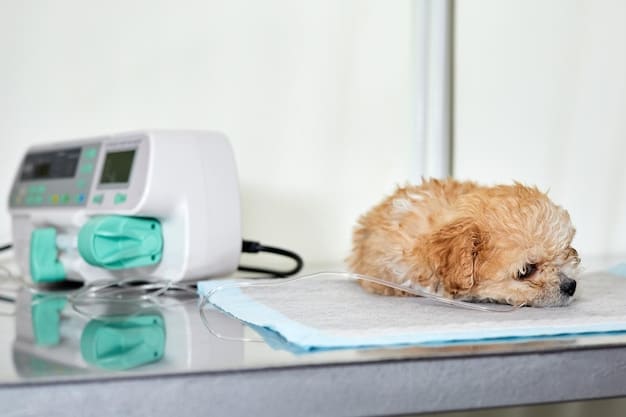
- Maternal antibodies decrease over time.
- Puppies’ immune systems are still developing.
- Rapidly dividing cells are targeted by the virus.
Understanding the nature of parvovirus and its transmission is the first step in protecting your puppy. Vaccination and strict hygiene practices are crucial for mitigating the risk and ensuring your puppy’s health.
Recognizing Parvovirus Symptoms
Early detection of parvovirus is critical for improving a puppy’s chances of survival. This section outlines the key symptoms to watch out for and emphasizes the importance of prompt veterinary attention.
Key Symptoms to Watch For
The symptoms of parvovirus can appear suddenly and progress rapidly. Common signs include severe vomiting, bloody diarrhea, lethargy, loss of appetite, and dehydration. Puppies may also develop a fever or low body temperature.
If you observe any of these symptoms in your puppy, it’s imperative to seek immediate veterinary care. Time is of the essence when dealing with parvovirus, as the condition can deteriorate quickly.
The Importance of Prompt Veterinary Attention
Parvovirus is a medical emergency that requires immediate veterinary intervention. Without treatment, the virus can lead to severe dehydration, electrolyte imbalances, and septic shock, which can be fatal.
Veterinary treatment typically involves intravenous fluids to combat dehydration, antiemetics to control vomiting, and antibiotics to prevent secondary bacterial infections. In severe cases, a blood transfusion may be necessary.
Seeking veterinary care promptly can significantly increase your puppy’s chances of survival and reduce the severity of the illness.
Recognizing the symptoms of parvovirus requires vigilance and quick action. Don’t hesitate to consult with your veterinarian if you suspect your puppy may be infected.
The Power of Vaccination
Vaccination is the most effective way to protect your puppy from parvovirus. This section explains the vaccination schedule and reinforces the importance of completing the series.
Understanding the Vaccination Schedule
Puppy vaccination schedules typically begin around 6-8 weeks of age and continue every 3-4 weeks until the puppy is 16 weeks old. The parvovirus vaccine is usually administered as part of a combination vaccine that also protects against other common canine diseases, such as distemper, adenovirus, and parainfluenza.
It’s crucial to follow your veterinarian’s recommended vaccination schedule and ensure your puppy receives all the necessary booster shots. This series of vaccinations is designed to build a strong and lasting immunity against parvovirus.
Why Completing the Series is Essential
Completing the entire vaccination series is essential because puppies respond differently to each dose. Maternal antibodies can interfere with the effectiveness of the initial vaccines, so multiple doses are needed to ensure the puppy develops a robust immune response.
Skipping or delaying vaccinations can leave your puppy vulnerable to parvovirus, even if they have received some initial doses. Adhering to the complete vaccination schedule provides the best possible protection against this deadly disease.
- Vaccinations start at 6-8 weeks of age.
- Boosters are given every 3-4 weeks.
- Complete the series by 16 weeks of age.
Vaccination is the cornerstone of parvovirus prevention. By following the recommended vaccination schedule, you can provide your puppy with a strong and lasting shield against this dangerous virus.
Maintaining Strict Hygiene Practices
In addition to vaccination, strict hygiene practices play a critical role in preventing parvovirus. This section details how to disinfect your environment and minimize the risk of exposure.
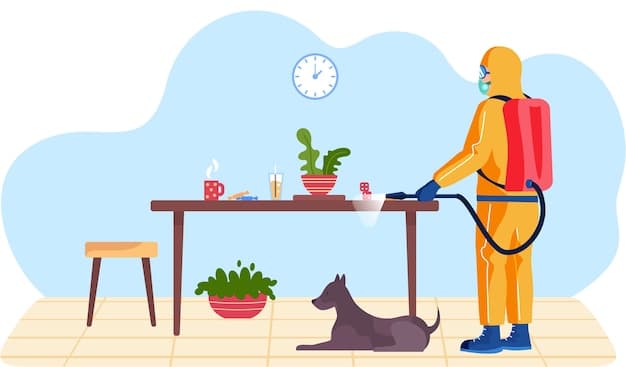
How to Disinfect Your Environment
Parvovirus is highly resistant to many common disinfectants, so it’s essential to use products specifically labeled as effective against the virus. Bleach is one of the most effective disinfectants for parvovirus. A solution of one part bleach to 32 parts water (approximately ½ cup of bleach per gallon of water) can be used to disinfect surfaces.
When disinfecting, make sure to thoroughly wet the surface and allow the solution to sit for at least 10 minutes before rinsing. Pay special attention to areas where your puppy may have had contact, such as floors, crates, and food bowls.
Always wear gloves and protective clothing when handling bleach solutions, and ensure that the area is well-ventilated to avoid inhaling fumes.
Minimizing the Risk of Exposure
To minimize the risk of parvovirus exposure, avoid taking your unvaccinated puppy to public places where other dogs may congregate, such as dog parks, pet stores, and sidewalks. Until your puppy is fully vaccinated, it’s best to keep them in a controlled environment.
When you have visitors, ask them to remove their shoes or disinfect them before entering your home, especially if they have been in contact with other dogs. Similarly, be cautious when introducing your puppy to new dogs, ensuring that they are fully vaccinated and healthy.
Hygiene is a powerful tool in preventing parvovirus. By maintaining a clean environment and minimizing exposure, you can significantly reduce the risk of infection for your puppy.
Boosting Your Puppy’s Immune System
A strong immune system is a puppy’s best defense against parvovirus. This section discusses the importance of nutrition and supportive care in maintaining your puppy’s health.
The Importance of Good Nutrition
A well-balanced diet is essential for supporting your puppy’s immune system. Feed your puppy a high-quality puppy food that is formulated with essential nutrients, vitamins, and minerals. Look for foods that contain antioxidants, which can help protect cells from damage.
Avoid feeding your puppy table scraps or unhealthy treats, as these can disrupt their digestive system and weaken their immune defenses.
Supportive Care and Stress Reduction
Stress can weaken a puppy’s immune system, making them more susceptible to parvovirus. Provide your puppy with a safe, comfortable, and stimulating environment to minimize stress.
Ensure your puppy gets plenty of rest and avoid exposing them to situations that may cause anxiety or fear. Regular gentle exercise can also help boost their immune system and overall health.
- Feed a high-quality puppy food.
- Provide essential nutrients and antioxidants.
- Minimize stress and ensure adequate rest.
A healthy immune system is a crucial component of parvovirus prevention. By providing good nutrition and supportive care, you can help your puppy build a strong defense against this deadly virus.
Navigating a Parvovirus Diagnosis
If your puppy is diagnosed with parvovirus, understanding the treatment process and providing supportive care at home are essential. This section offers guidance on what to expect and how to help your puppy recover.
Understanding the Treatment Process
Parvovirus treatment typically involves hospitalization and intensive supportive care. Veterinarians will administer intravenous fluids to combat dehydration, antiemetics to control vomiting, and antibiotics to prevent secondary bacterial infections.
In severe cases, a blood transfusion may be necessary to replace lost blood and provide essential antibodies. The treatment process can be lengthy and expensive, but it’s crucial for giving your puppy the best chance of survival.
Providing Supportive Care at Home
Once your puppy is discharged from the hospital, it’s essential to continue providing supportive care at home. Follow your veterinarian’s instructions carefully regarding medication, feeding, and hygiene practices.
Offer your puppy small, frequent meals of easily digestible food, such as boiled chicken and rice. Ensure they have access to fresh water at all times and monitor them closely for any signs of relapse.
Keep your puppy isolated from other dogs for at least two weeks after recovery to prevent the spread of the virus. Disinfect your home thoroughly to eliminate any remaining traces of parvovirus.
A parvovirus diagnosis can be overwhelming, but with prompt veterinary care and dedicated supportive care at home, your puppy can make a full recovery. Stay positive and follow your veterinarian’s guidance to help your puppy get back on their paws.
| Key Point | Brief Description |
|---|---|
| 💉 Vaccination | Essential for building immunity; follow vet’s schedule. |
| 🧼 Hygiene | Use bleach solution to disinfect; minimize exposure to public areas. |
| 🍎 Nutrition | Feed high-quality puppy food; avoid table scraps. |
| 🚨 Early Detection | Recognize symptoms (vomiting, diarrhea); seek vet care immediately. |
Frequently Asked Questions (FAQ)
▼
Parvovirus is typically diagnosed through a fecal test performed by a veterinarian. This test detects the presence of the virus in the puppy’s stool and provides a rapid and accurate diagnosis.
▼
While parvovirus primarily affects puppies, adult dogs can also contract the virus if they are unvaccinated or have a weakened immune system. However, the disease is typically less severe in adult dogs.
▼
Parvovirus is extremely resilient and can survive in the environment for months, even years, especially in shaded areas. This makes it essential to disinfect thoroughly and minimize exposure risks.
▼
There is no specific cure for parvovirus, but supportive care can significantly improve a puppy’s chances of survival. Treatment focuses on managing symptoms and preventing secondary infections.
▼
The survival rate for puppies with parvovirus can vary depending on the severity of the illness and the promptness of treatment. With intensive veterinary care, the survival rate can be as high as 90%.
Conclusion
Protecting your puppy from parvovirus requires a comprehensive approach that includes timely vaccination, strict hygiene practices, good nutrition, and prompt veterinary care. By understanding the risks and taking proactive steps, you can help your puppy live a happy and healthy life.
